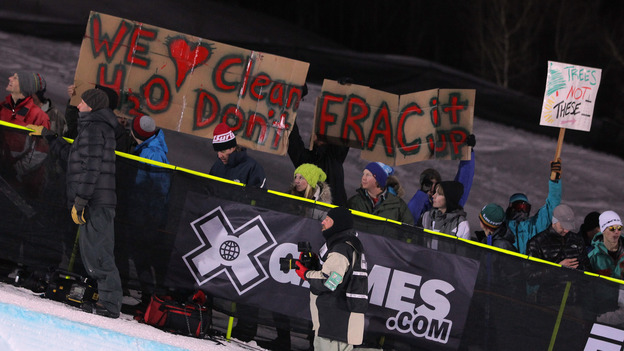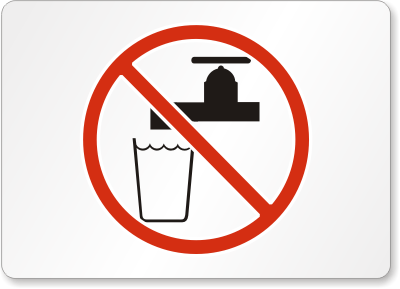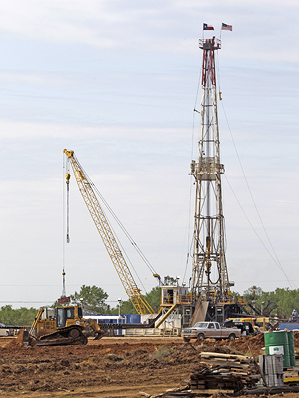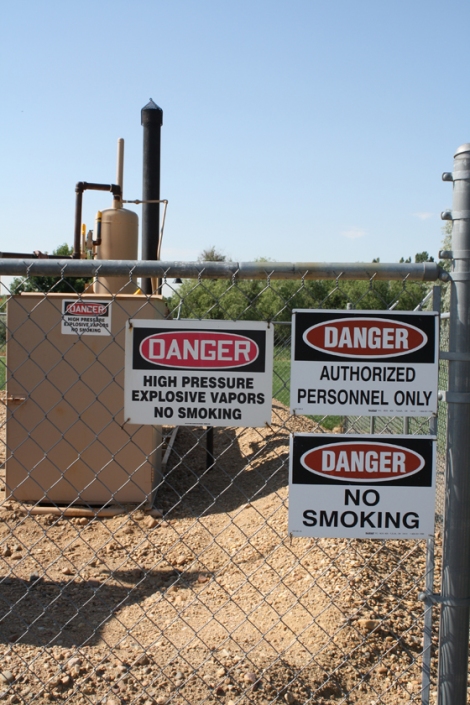To frack or not to frack?

Anti-fracking voices are heard far and wide, including in last weekend’s Winter X Games (via NPR).
Folks in Youngstown, Ohio might take the cake for the most harrowing of New Year’s Eves; the Midwest town brought in 2012 with a December 31 earthquake. This event raised a red flag to local residents, who wondered if there was more behind the natural disaster than pure coincidence. Unusual seismic activity and environmental issues have spiked in other communities with nearby hydraulic fracturing (“fracking”) and horizontal drilling operations as well. Consequently, such instances have sparked a national debate as to what fracking is, or isn’t, doing to the environment.

Fracking fluids include chemicals, which can be problematic if they spread to drinking water wells (via MySafetySign).
According to the EPA, fracking is a technique used to unlock gas that’s highly dispersed in rock formations by pumping mass amounts of liquid into the ground. The liquid consists of water, proppant and chemical additives that break up the rock and keep the fractures open. When the fluid reemerges to the surface, it’s trucked off to waste water facilities for disposal. However, 90% of the chemical-laden water is disposed by injecting it underground again. From a glance, this process can seem unnerving and damaging, although many argue such criticism is baseless.

Fracking takes place in states such as Oklahoma, Texas, Ohio and Colorado, while several more are considering it (via MIT Technology Review).
Proponents in the energy industry argue that these operations that extract oil and gas reserves from underground usher in countless domestic benefits during difficult economic times, including a newfound independence from foreign oil and stable energy prices. Substantial job growth in the oil and gas industry is evident, climbing 27.5% from January 2008 to August 2012, in comparison to a 3.4% drop in nationwide payroll employment. Fracking activity has boosted tax revenue for states and municipalities, along with business growth and increased investment opportunities.

Colorado requires drilling sites to be more than 500 feet away from homes and schools (via Boulder Weekly).
On the other hand, the opposition cites a number of cases where fracking sites damaged the nearby ecosystem and environment, proving lethal at times. A 2012 study suggests that run-off wastewater was a likely cause of the death of livestock and pets. Chief among concerns are toxic chemicals entering and contaminating drinking water supplies, worsening air quality, and threatening workplace safety. Such accusers argue that public health woes pose a greater cost than the benefits provided.
Whether you’re drinking a chilled bottle of your local microbrew ale or glass of 10-cent lemonade you bought from the kids down the street, you may want to stay tuned to stories in the news (you can even see a version of fracking dangers to small communities on the big screen, in Promised Land, starring Matt Damon) and developments in scientific research. The reality is, despite the uncertainty of their impacts, fracking and horizontal drilling could be coming to a Small Town USA near you.













